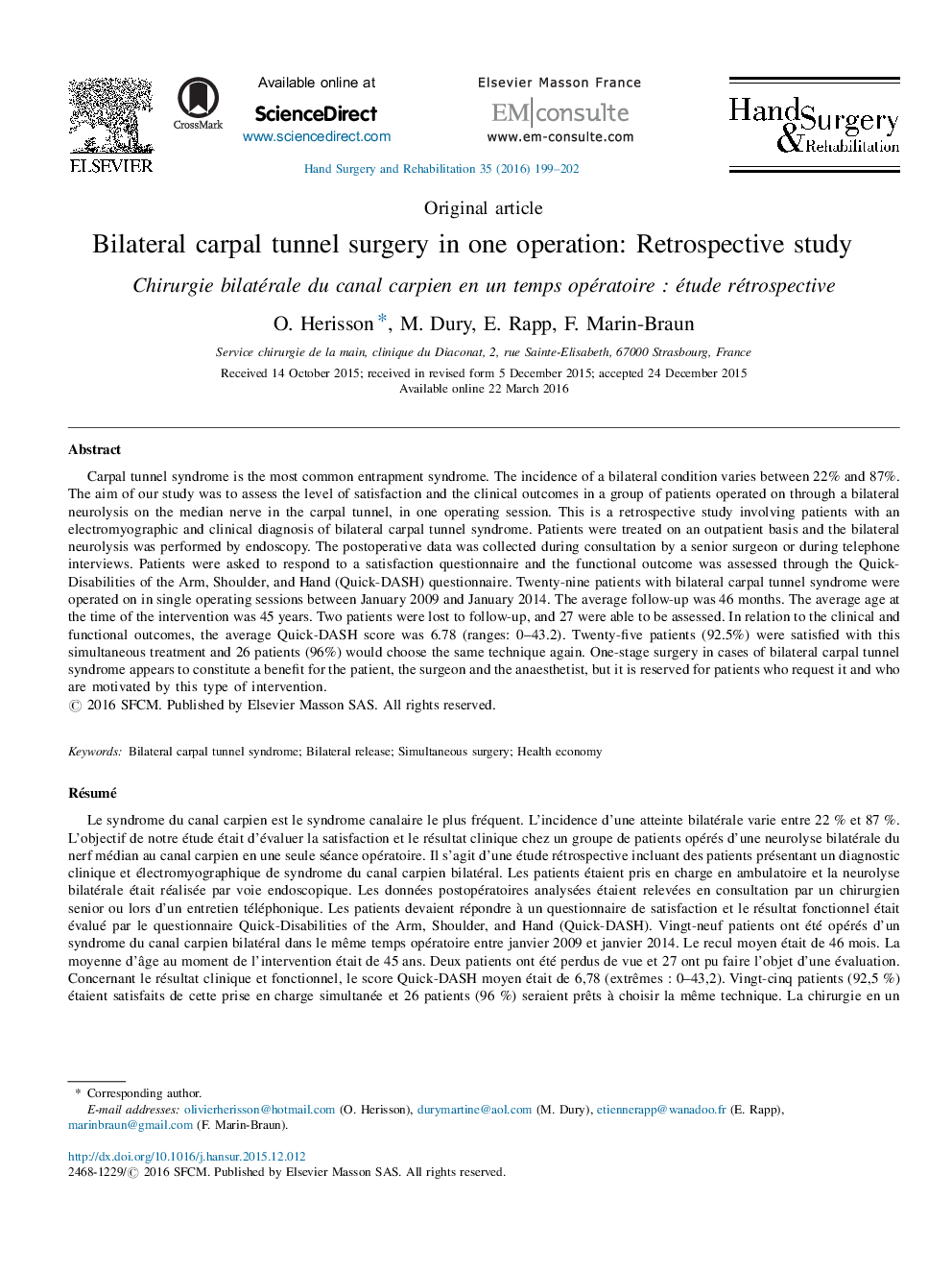| کد مقاله | کد نشریه | سال انتشار | مقاله انگلیسی | نسخه تمام متن |
|---|---|---|---|---|
| 4059754 | 1265867 | 2016 | 4 صفحه PDF | دانلود رایگان |
Carpal tunnel syndrome is the most common entrapment syndrome. The incidence of a bilateral condition varies between 22% and 87%. The aim of our study was to assess the level of satisfaction and the clinical outcomes in a group of patients operated on through a bilateral neurolysis on the median nerve in the carpal tunnel, in one operating session. This is a retrospective study involving patients with an electromyographic and clinical diagnosis of bilateral carpal tunnel syndrome. Patients were treated on an outpatient basis and the bilateral neurolysis was performed by endoscopy. The postoperative data was collected during consultation by a senior surgeon or during telephone interviews. Patients were asked to respond to a satisfaction questionnaire and the functional outcome was assessed through the Quick-Disabilities of the Arm, Shoulder, and Hand (Quick-DASH) questionnaire. Twenty-nine patients with bilateral carpal tunnel syndrome were operated on in single operating sessions between January 2009 and January 2014. The average follow-up was 46 months. The average age at the time of the intervention was 45 years. Two patients were lost to follow-up, and 27 were able to be assessed. In relation to the clinical and functional outcomes, the average Quick-DASH score was 6.78 (ranges: 0–43.2). Twenty-five patients (92.5%) were satisfied with this simultaneous treatment and 26 patients (96%) would choose the same technique again. One-stage surgery in cases of bilateral carpal tunnel syndrome appears to constitute a benefit for the patient, the surgeon and the anaesthetist, but it is reserved for patients who request it and who are motivated by this type of intervention.
RésuméLe syndrome du canal carpien est le syndrome canalaire le plus fréquent. L’incidence d’une atteinte bilatérale varie entre 22 % et 87 %. L’objectif de notre étude était d’évaluer la satisfaction et le résultat clinique chez un groupe de patients opérés d’une neurolyse bilatérale du nerf médian au canal carpien en une seule séance opératoire. Il s’agit d’une étude rétrospective incluant des patients présentant un diagnostic clinique et électromyographique de syndrome du canal carpien bilatéral. Les patients étaient pris en charge en ambulatoire et la neurolyse bilatérale était réalisée par voie endoscopique. Les données postopératoires analysées étaient relevées en consultation par un chirurgien senior ou lors d’un entretien téléphonique. Les patients devaient répondre à un questionnaire de satisfaction et le résultat fonctionnel était évalué par le questionnaire Quick-Disabilities of the Arm, Shoulder, and Hand (Quick-DASH). Vingt-neuf patients ont été opérés d’un syndrome du canal carpien bilatéral dans le même temps opératoire entre janvier 2009 et janvier 2014. Le recul moyen était de 46 mois. La moyenne d’âge au moment de l’intervention était de 45 ans. Deux patients ont été perdus de vue et 27 ont pu faire l’objet d’une évaluation. Concernant le résultat clinique et fonctionnel, le score Quick-DASH moyen était de 6,78 (extrêmes : 0–43,2). Vingt-cinq patients (92,5 %) étaient satisfaits de cette prise en charge simultanée et 26 patients (96 %) seraient prêts à choisir la même technique. La chirurgie en un temps du syndrome du canal carpien bilatéral semble représenter un bénéfice pour le patient, le chirurgien et l’anesthésiste, mais elle est réservée à un patient demandeur et motivée par ce mode de prise en charge.
Journal: Hand Surgery and Rehabilitation - Volume 35, Issue 3, June 2016, Pages 199–202
